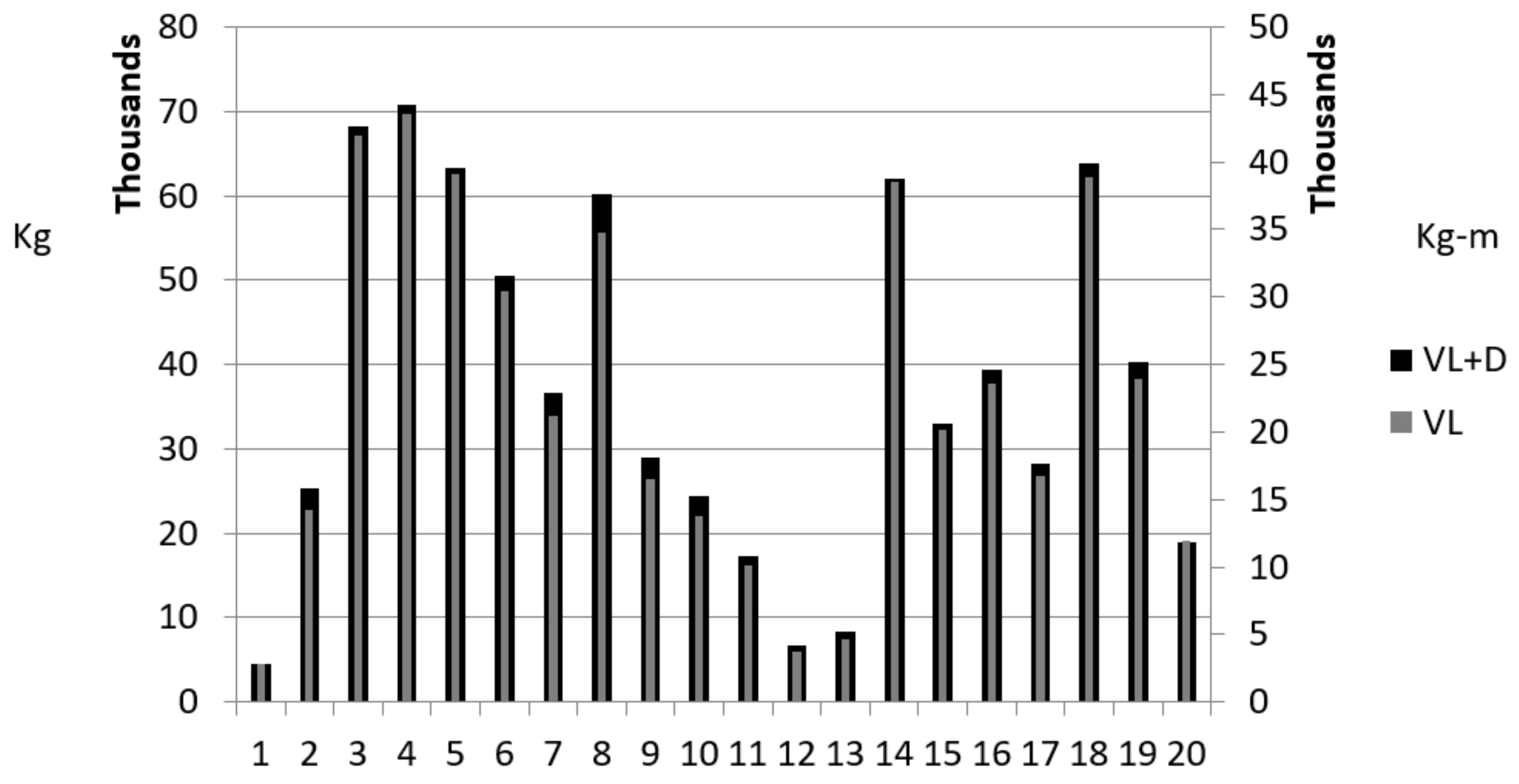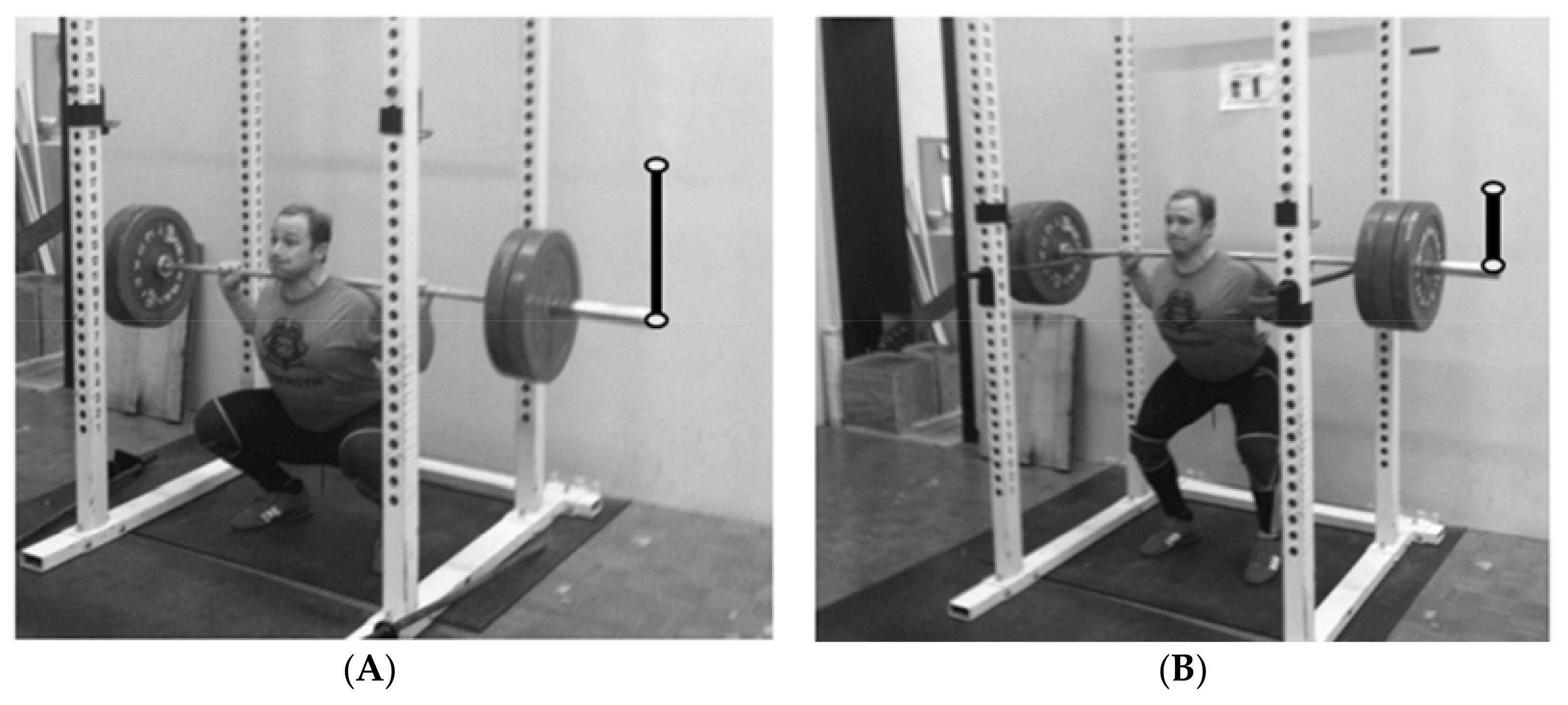1. Introduction
Appropriate quantification of resistance training volume is believed to be a necessary step in understanding the link between training and the associated adaptations. Detailed resistance training studies report estimates of work from all resistance training sessions, allowing their studies to be reproducible [
1,
2,
3,
4], and coaches commonly track the volume of their exercise prescriptions. Acute and prolonged physiological responses to stress derived from resistance training can include hormonal alterations [
5,
6], increased energy expenditure [
7], and neuromuscular fatigue [
8]. Häkkinen [
8] demonstrated that the greater the amount of resistance training work performed during a single training session, the greater the physiological disturbance [
8]. Thus, more accurate estimations of work (training volume) could be beneficial in associating training volume with potential fatigue and recovery resulting from the disturbance of homeostasis. Monitoring resistance training volume can be critical for several reasons:
It allows coaches to monitor whether or not the pre-planned training volume closely matches the volume actually performed in training;
It allows coaches to better achieve targeted volume ranges for specific phases of training that involve a targeted objective (e.g., a strength endurance phase requires a greater training volume than a power phase);
It allows superior management of training volume from one phase (e.g., block) of training to the next (e.g., a desired drop in training volume);
It allows long term monitoring (e.g., when an athlete returns to a similar block of training, are they performing more work?).
Exercise displacement is calculated by the distance covered for a given movement task, and for free weight barbell exercises, displacement can be assessed as the distance the barbell travels during the concentric (vertical) portion of a resistance exercise for a single repetition. In a review on quantifying workloads in resistance training, Haff [
9] explains that the mechanical work performed by an athlete can be quantified by multiplying the athlete’s force times displacement for each repetition. From a study by McBride et al. [
10], in which four different volume assessment protocols were compared using force plate assessments, the authors stated that “total work” (TW) (force (N) × displacement (m)) was the “most valid” of the four resistance training quantification protocols examined. This was based upon TW being a direct measure of mechanical work and the other three volume estimations (reps × load, time under tension, and repetitions × (body mass − shank mass + external load)) each having specific limitations, as noted by the investigators [
10].
Volume load (VL) (repetitions × load) has been reported in long-term resistance training studies for the past several decades. Haff [
9] explains that displacement can be added to VL, the most common resistance training volume calculation, thus resulting in VLwD (repetitions × load × displacement). This may be warranted, because, for a practitioner, measuring the forces generated for every repetition is impractical. In 1987, Stone et al. [
11] published a descriptive study on high repetitions (sets of 10) of back squats and an individual’s physiological response. To the authors knowledge this study was the first to include displacement in VL calculations. Over the last several years, Stone and colleagues have begun to use VLwD as an estimate of work in resistance training studies, for example, Bazyler et al. 2017 [
4], Bayzler et al. 2018 [
12], Caroll et al. [
13], and Hornsby et al. [
14].
Over the course of a macrocycle, exercises can change based on the overall goals of a specific block of training. Thus, the tracking of training volume from one phase of training to the next is a common consideration for the management of resistance volume. Block periodization models commonly involve a transition across the macrocycle from periods of higher volume to periods of lower volume. Though changes in the number of overall repetitions plays a major role in resultant volume alterations (e.g., decreasing across a macrocycle), so too does the manipulation of training load, as well barbell displacement alterations, via changes in exercises. Exercises commonly change from one phase (block) to the next due to changes in the coaches’ adaption objective(s). For example, during the accumulation block, training may consist of a greater amount of large range of motion exercises, whereas during a realization block, with a taper, a greater amount of partial range of motion exercises may be included in the training program. Exercise intensity (i.e., external load for a given resistance exercise) is commonly factored into volume estimations (e.g., VL), and its impact on an individual’s acute physiological response (e.g., heavier or lighter loads) has been well examined [
5].
McBride et al.’s [
10] study demonstrated that exercise displacement provides a more accurate assessment of resistance training volume. However, McBride et al. [
10] calculated exercise displacement along with force output and did not compare displacement to VL. Previously, no longitudinal study has been performed comparing changes in VL with and without exercise displacement. Practitioners are likely less interested in the accuracy of their resistance training volume assessment compared to how well changes in their volume calculation reflect changes in an athlete’s overall workload. Based on Haff [
9] and McBride et al. [
10], the inclusion of exercise displacement into VL provides a more accurate estimation of training volume. The authors of the present study were interested in how worthwhile it would be, for the coach or strength and conditioning specialist, to include displacement measures along with VL calculations; specifically, is it worth the additional time to collect? If differences exist between VL and VLwD it can be surmised that VLwD is a more accurate estimation of work performed. Thus, the aim of this study was to compare the VL and VLwD during individual blocks of training, select training weeks, and select training days to determine if there are meaningful differences between these methods. For example, if differences exist between VL and VLwD when changing from one specific training period to another, this would suggest that VLwD is worth the additional time. The authors hypothesized that the inclusion of barbell displacement would, for certain periods of training (e.g., when greater changes in volume occur), result in differences in reported workloads performed by the weightlifters. The authors considered it advantageous to observe training in athletes in an ecologically valid environment (i.e., normal training and coaching conditions) over a prolonged period, as this better mirrors real-world training situations.
4. Discussion
Good fatigue management is paramount. Importantly, the percent changes for four of the seven time periods investigated demonstrated statistically significant differences. These differences were displayed when a comparison was made between high(er) and low(er) volume training blocks, in which there was a large contrast in training volume. Similar results were noted for heavy and light days. Thus, if a coach wants to be assured that changes in training volume are best represented it is worth including displacement (VLwD).
In addition to disparities in volume as a result of changes in the number of prescribed repetitions, another important consideration for changes in VLwD, and not necessarily VL, is changes in range of motion (displacement) due to changes in exercise selection from one training block to the next. For example, full movements may eventually switch to partial movements later in the macrocycle. A switch from a full movement exercise to a partial movement exercise (e.g., full squat replaced with a quarter squat) is common when a coach implements either a taper or an in-season maintenance program. Heavier loading is typically used with partial movements (but less displacement) and thus, when comparing a quarter squat (see
Figure 3 below) to a full squat, the load for the quarter squat will be much higher for the same relative training intensity. However, when taking into account barbell displacement, the VL is less than when compared to executing the full movement.
Table 7 illustrates this difference. Additionally, based on the data generated from the current study, differences in relative work when switching from block to block can be underestimated using only VL (
Table 7).
Although the use of VLwD requires some additional effort, its use provides a more accurate characterization of loading. Based on the data in the present study, a coach may mischaracterize the changes between loading periods by using VL. Factors influencing a potential difference between a change in VL and VLwD likely include the changes in the number of partial versus full movements, and the relative alterations between loading periods (e.g., heavy and light days, high volume block to low volume block).
5. Conclusions
The direct measurement of weight training volume can involve measuring forces, displacement of the external load, and the energy expenditure. Thus, researchers can examine various methods of estimating weight training volume by comparing it to direct measurements. Volume load has been shown to be a reasonable estimate of work when compared to the direct measurements of forces and barbell displacement (i.e., mechanical work) in the back squat; however, is not as accurate as when including exercise displacement (one of the two variables for quantifying mechanical work) [
10].
The process of calculating VLwD is certainly more time consuming than for VL; however, sound planning and structure can minimize the burden and provide a rather efficient system. This can include: (1) Measuring exercise displacements before implementing several blocks of training (e.g., the first day of team training for a given year or season); and (2) inserting the displacements for the given exercises into excel, allowing VLwD to be “auto-calculated”, following data imputation (e.g., loads and repetitions). Based on the present study findings and previous research [
10], despite the calculation VLwD being more time-consuming compared to VL (i.e., load x repetitions), coaches and sports scientists are recommended to use VLwD to provide estimates of work in a more meaningful fashion.











